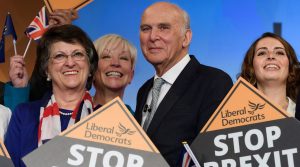
The actual results were exciting, with pro-Remain parties getting more votes than pro-Brexit ones and many people voting Liberal Democrat who would not have done so a year ago.
Polling from Lord Ashcroft since then suggests that many of these voters would follow this up by voting Liberal Democrat in a UK General Election.
The campaigner in me instinctively thinks this is the time to be out and visible, particularly in places where people don’t hear from us very often. It’s one thing for people to vote Liberal Democrat in exceptional circumstances and quite another if it’s followed up by enough contact to mean this is not a flash in the pan. On top of the usual task helping newly-elected councillors to dig in, this is a golden opportunity to recruit members and deliverers.
But things are not so simple.
Anxiety on the doorstep
To get a sense of the general temperature, I did some canvassing in Hertford and Stortford constituency shortly before the European elections by knocking on every door in certain areas (rather than just going to those likely to support Liberal Democrats or Remain). What I encountered was a seemingly-small (though often strident) number of people who were going to vote for the Brexit Party, others happy to say they were voting Liberal Democrat, and a smaller number, loyal to Conservatives or Labour, following their loyalty with some unease. But a strikingly-large number of conversations were with people who said they were worried and didn’t know how to vote.
At first I wasn’t sure whether these were supporters of Remain or Leave. On autopilot I took the conversation to Remain United’s advice to vote Liberal Democrat if people wanted to remain in the EU, thinking that I would get pushback if the person supported Brexit. But instead of pushback, these conversations were often ending in the promise of a Liberal Democrat vote.
This experience doesn’t put the Brexit Party in first place and contradicts the voting figures for the district: the Brexit party first on 14,374 followed by Liberal Democrats on 11,090. But the overall turnout was 36.9%. This leaves me wondering how many of those “worried and not sure how to vote” didn’t actually vote.
Connecting emotionally with the “worried and not sure how to vote”
The “Bollocks to Brexit” slogan at last brought some emotion to the foreground on the Remain side and brought a major swing to the Liberal Democrats.
But the “worried and not sure how to vote” are not feeling positive. The worry is real. Things are disorientating. The Tories are a long way from stable government, and Labour just as far from being a credible government-in-waiting. The Scottish government is proposing another independence referendum by 2021, and the phrase “existential crisis” being used
One of the positives of “Bollocks to Brexit” is that it does point out that we can end the #BrexitMadness by choosing to remain in the EU. This is about sanity and stability, as well as identity, culture and economics.
On top of this, Liberal Democrats and Tories are both going into leadership elections, but they couldn’t be more different. The Tories have removed a leader who failed to do the impossible, and are faced with a parade of candidates who send a shudder down the spine. The Liberal Democrats have a leader standing down after brilliant election results and what looks like being an orderly campaign to chose between Liberal Democrat contenders who come across as trustworthy and proficient. This too is a contrast which says to the electorate “There is a sane option”.
Connecting with the public on the doorstep, on social media and in print offers a stability that is sadly lacking from Conservatives and Labour. This is a golden opportunity to put the case for an Exit from Brexit and for Liberal Democrat values. This is also to do our bit in finding a way out of the present mess. Along the way, that it will make it easier for people who voted Liberal Democrat in the European Parliament elections to continue doing this.